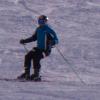У сноубордеров Давно все разжевано про разгрузки и кросс\ овер/андер.
Еще до того, как Лемастер начал нести свои заблуждения про ускорения в массы .
Ле Мастер издал книгу в 1999г. А ссылка на 2003г
Более того
There are a few ways to change edges:
- Cross-over: Your board stays where it is and your body travels up and over the board in an arc. In this style, you bring your torso up (placing weight on the board as you move up) and then you sink back down to begin the next carve (unweighting the board as you sink). This technique is easier and more natural to learn, but it does not work well on steeps because it takes too long to change edges.
- Cross-under: Your torso stays where it is and your lower body swings back and forth underneath you to change edges. In this style, you bring your legs in (unweighting), then you hop to a new edge for the next turn (placing weight on the board as you enter the next carve). You can change edges quicker than in the cross-over style, however you don't hold edge pressure for as long. [Cross-under and cross-over terminology was used for a long time in skier ETS (Examiner Training Squad) certification.]
- Cross-through: A good technique for ice and steeps, which is a combination of cross-over and cross-under. It consists of bringing your center of gravity straight across the board and downhill by partially unweighting before an edge change, while your knees roll to the next edge. Instead of rising up and then sinking, like in the cross-over, you stay low the entire time. In fact, your body starts out low and gets even lower when your center of gravity passes over the board. The term cross-through was originally coined by Tom Reynolds, a ski coach at UMaine Farmington. Erik Beckman later applied the term to snowboarding in his 1994 self-published book.












